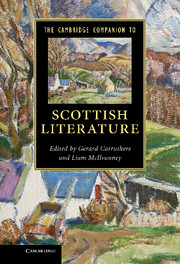Book contents
- Frontmatter
- Contents
- Notes on Contributors
- Acknowledgements
- Chronology
- Introduction
- 1 Scottish Literature before Scottish Literature
- 2 The Medieval Period
- 3 Reformation and Renaissance
- 4 The Aftermath of Union
- 5 Robert Burns
- 6 Enlightenment, Romanticism and the Scottish Canon
- 7 Scott and the Historical Novel
- 8 The Gaelic Tradition
- 9 Scottish Gothic
- 10 Victorian Scottish Literature
- 11 Robert Louis Stevenson
- 12 Hugh MacDiarmid and the Scottish Renaissance
- 13 Popular Fiction
- 14 Muriel Spark
- 15 The Glasgow Novel
- 16 ‘What is the language using us for?’
- 17 The Emergence of Scottish Studies
- 18 Otherworlds
- 19 Scottish Literature in Diaspora
- Index
- References
11 - Robert Louis Stevenson
Published online by Cambridge University Press: 05 January 2013
- Frontmatter
- Contents
- Notes on Contributors
- Acknowledgements
- Chronology
- Introduction
- 1 Scottish Literature before Scottish Literature
- 2 The Medieval Period
- 3 Reformation and Renaissance
- 4 The Aftermath of Union
- 5 Robert Burns
- 6 Enlightenment, Romanticism and the Scottish Canon
- 7 Scott and the Historical Novel
- 8 The Gaelic Tradition
- 9 Scottish Gothic
- 10 Victorian Scottish Literature
- 11 Robert Louis Stevenson
- 12 Hugh MacDiarmid and the Scottish Renaissance
- 13 Popular Fiction
- 14 Muriel Spark
- 15 The Glasgow Novel
- 16 ‘What is the language using us for?’
- 17 The Emergence of Scottish Studies
- 18 Otherworlds
- 19 Scottish Literature in Diaspora
- Index
- References
Summary
Summing up his friend’s career to date in 1886, Henry James wrote of Robert Louis Stevenson: ‘Each of his books is an independent effort – a window opened to a different view.’ In its simplest sense, this remark recalls the experimental, adaptable attitude that Stevenson took to literary forms in a market that afforded authors new freedoms. At the start of his writing career in the 1870s, the book trade was still dominated by the standard, three-volume novel, looming large in the view of any young writer beginning a literary career. As Stevenson himself put it, ‘the fact of the existence of the modern English novel is not to be denied; materially, with its three volumes, leaded type, and gilded lettering, it is easily distinguishable from other forms of literature’. But throughout Stevenson’s life, sales of the three-volume novel, the medium of Charles Dickens and George Eliot, began to fall and the ‘other forms of literature’ to take their place. With the increasing popularity and widening distribution of magazines, shorter fictions and serial publication drove the development of literature, and new literary modes began to emerge to satisfy new readerships. Not yet quite solidified into the genres we would now recognise, these modes blended with each other as authors felt unconstrained by the demands of the realist novel. Strange Case of Dr Jekyll and Mr Hyde (1886), for example, could be described as an early example of many genres: the detective work of Mr. Utterson (or ‘Mr. Seek’ as he calls himself), Henry Jekyll’s mysterious chemical experiment and the monster that is Hyde are all potent models for, respectively, the detective story, science fiction and horror, yet the novel cannot be said to correspond precisely to any one of these genres.
- Type
- Chapter
- Information
- The Cambridge Companion to Scottish Literature , pp. 159 - 172Publisher: Cambridge University PressPrint publication year: 2012

